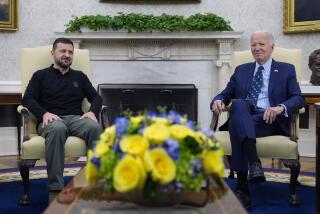Russians Renew Pledge to Destroy Chemical Arsenal
- Share via
SHCHUCHYE, Russia — The flags of the United States and nine other countries went up here Friday over the planned site of a chemical weapons destruction facility as part of a new campaign to demonstrate that Russia has finally gotten serious about eliminating its stockpiles of nerve gas and other lethal agents.
Washington has pledged $888 million to help Russia destroy its 40,000 tons of chemical weapons and has already paid about $260 million. But, complaining of a lack of commitment by the Russians, the U.S. Congress has blocked further appropriations.
The Bush administration is conducting a wide-ranging review of assistance programs to Russia and is expected to announce in coming weeks whether it will continue to support such programs, including construction of the destruction facility in Shchuchye, a town in the Ural Mountains that has one of Russia’s largest stockpiles.
“Last year, Russia wasn’t fulfilling its obligations and wasn’t supplying enough money,” Sergei V. Kiriyenko, a former prime minister who is chairing a new presidential commission on chemical weapons, acknowledged Friday. Dozens of officials from Western Europe and the United States had come here for the flag-raising and a daylong series of events.
“The situation has changed markedly this year,” Kiriyenko said. “We can present a fully developed program. This year, the Congress has a real reason to change its policy.”
Under the programs agreed to by the United States and Russia in the early 1990s, the Shchuchye plant was to be the centerpiece of Russian efforts to dismantle and destroy its chemical agents.
During the Cold War, Russia stockpiled about 40,000 tons of such weapons, much of it lethal nerve gas like the sarin that killed 12 people in a Tokyo subway in 1995. The United States had stockpiled about 30,000 tons.
By the 1980s, both countries had realized that the stockpiles were militarily useless, since an attempt by either nation to use the weapons would pose unacceptable dangers to its own troops. That’s when Washington and Moscow started talks on eliminating their hoards.
In 1997, Russia ratified the international Chemical Weapons Convention and promised to destroy its arsenal by 2007. Plans called for the construction of destruction facilities at each of its seven major stockpile sites, to be built jointly by Russia and international partners.
The facility in Shchuchye is expected to be the largest, capable of destroying at least 800 tons of nerve gas a year. It will start with the arsenal of 2 million artillery shells and several thousand rockets stored here. Just one of the shells could kill a football stadium full of people; the rockets could take out a metropolitan area the size of Los Angeles. And Shchuchye accounts for only about 14% of Russia’s stockpile.
“The elimination of these weapons is absolutely in the interest of all nations,” Kiriyenko said.
Russian officials acknowledge that, until now, chemical weapons destruction had a low priority. American inspectors say Russia’s arsenal is in better condition than U.S. weapons, with comparatively little deterioration and a safe shelf life of several more decades. And the cost of eliminating the stockpiles--between $4 billion and $6 billion--is prohibitive for a country with Russia’s economic problems.
However, concern has grown that the sheer size of the stockpiles and their storage in poorly guarded facilities in rural areas make them vulnerable to theft by would-be terrorists. Although beefing up security would be a temporary solution, in the long term, destruction is the only safe option.
Last November, Russian President Vladimir V. Putin signed an order transferring chemical, nuclear and biological weapons disposal from the Defense Ministry to the civilian Russian Munitions Agency, and Russian work on the program accelerated. This year, the Kremlin has put $120 million into the project, a figure that Russian officials say is six times their previous appropriation.
“I’m convinced they have the intent to do everything possible to comply with the treaty,” said Thomas Kuenning, a retired Army general who directs the U.S. Cooperative Threat Reduction Program.
There is little to see at the site of the planned facility in Shchuchye, whose lead contractor is a division of Pasadena-based Parsons Corp. The ground has been graded and some of the birch forest cleared; a crane stands idle. The U.S. has committed only to completing the design and other preparations for construction--ground will not be broken without a decision in Washington.
Congress imposed several conditions to resuming funding. The most important is a greater commitment to funding by both the Russian government and international allies.
So far, nine countries have committed $70 million, mostly for programs to improve the infrastructure around Shchuchye. But new pledges are unlikely without a renewed commitment from the United States, experts say.
“They are all on the fence waiting to see what happens in our government,” said Paul McNelly, the chemical weapons program manager in the threat reduction agency.
More to Read
Sign up for Essential California
The most important California stories and recommendations in your inbox every morning.
You may occasionally receive promotional content from the Los Angeles Times.













